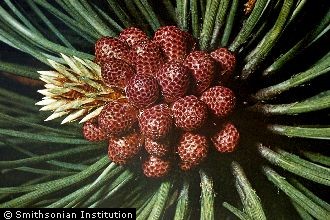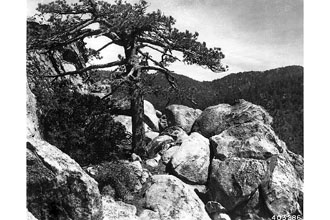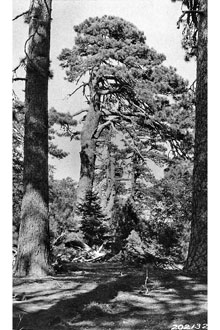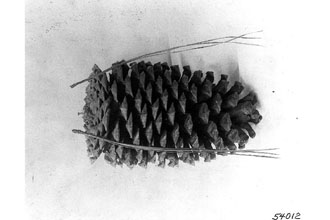Pinus ponderosa Lawson & C. Lawson ssp. jeffreyi (Balf.) Engelm.
Scientific Name: Pinus ponderosa Lawson & C. Lawson ssp. jeffreyi (Balf.) Engelm.

| General Information | |
|---|---|
| Usda Symbol | PIPOJ |
| Group | Gymnosperm |
| Life Cycle | Perennial |
| Growth Habits | Tree |
| Native Locations | PIPOJ |
Plant Guide
Uses
Ethnobotanic use. The turpentine obtained from the resin of all pine trees is antiseptic, diuretic, rubefacient and vermifuge. It is a valuable remedy used internally in the treatment of kidney and bladder complaints and is used both internally and as a rub and steam bath in the treatment of rheumatic affections. It is also very beneficial to the respiratory system and so is useful in treating diseases of the mucous membranes and respiratory complaints such as coughs, colds, influenza and externally it is a very beneficial treatment for a variety of skin complaints, wounds, sores, burns, boils etc and is used in the form of liniment plasters, poultices, herbal steam baths and inhalers. Commercial uses: The primary use for Jeffrey pine is for lumber. The low-grade Jeffrey pine trees are processed into dimensional lumber, as well as other construction products. Some of the other construction products made from high-grade lumber, as a raw material are molding, millwork, cabinets, doors, and windows. It is important to note that for commercial use, no distinction is made between the wood of Jeffrey pine and ponderosa pine. Pure n-heptane is distilled from Jeffrey Pine resin. It was selected as the zero point on the petrol octane rating scale. Jeffrey Pine resin cannot be used to make turpentine, as n-heptane is explosive when ignited. Wildlife uses: The Jeffrey pine forests provide wildlife cover for birds, small mammals and big game. Its’ seeds are both disseminated and eaten by insects, birds, and small mammals such as mice, chipmunks, and tree squirrels.
Status
Please consult the PLANTS Web site and your State Department of Natural Resources for this plant’s current status (e,g, Use soil moisture sensors to measure the soil moisture of Pinus ponderosa Lawson & C. Lawson ssp. jeffreyi (Balf.) Engelm.., threatened or endangered species, state noxious status, and wetland indicator values),
Description
General: The Jeffrey pine may live 400 to 500 years and can attain immense size. It typically grows to 4 to 6 feet in diameter, and 170 to 200 feet in height. To date, the largest Jeffrey pine recorded in the western Sierra Nevada had a diameter of 7.5 feet, and a height of 175 feet. The Jeffrey pine needles are in bundles of three (3), and are 7 to 11 inches long. Its’ cones are 6 to 10 inches long, and oval lacking the spines, which make ponderosa pine cones prickly. The Jeffrey pine bark is deeply furrowed, and reddish-brown compared to orange of the ponderosa pine. It also has a strong vanilla or pineapple odor. Distribution: Jeffrey pine is found primarily in California extending north through the Klamath Mountains into southwestern Oregon, across the Sierra Nevada into western Nevada, and south to the Transverse and Peninsular Ranges and into northern Baja California. In the northeast, central, and southern portions of its range, climate and elevation determine its distribution, rather than soil type. Habitat: The Jeffrey pine can occupy many sites from the edges of moist, high mountain meadows to arid slopes bordering deserts, and it will grow over a wide range of elevations. The Jeffrey pine also grows in a diverse range of climatic conditions. It grows well on harsh and infertile sites. It is tolerant of drought, adapts to cold weather because it requires a shorter growing season than the ponderosa pine. Cold winters largely determine its presence in the Klamath, western Sierra Nevada, and southern California ranges.
Adaptation
The Jeffrey pine grows on a wide variety of well-drained soils. In the northwest portion of its range, the Jeffrey pine grows on infertile soils. However, it typically grows on infertile soils, mostly shallow and fine, fine loamy, and clay-textured gravelly surface soils. This pine grows at elevations as low as 200 feet. In the Sierra Nevada, Jeffrey pine typically grows on volcanic soils with coarse soil texture, as gravelly sandy loams or loamy coarse sands. Jeffrey pine grows at elevations from 1,600 to over 9,000 feet. Jeffrey pine has exhibited potential for re-vegetation of acid mine waste sites in northeastern California. It was found to be well adapted to a sulfur mine spoil site that was high in acidity and low in nitrogen availability.
Establishment
The Jeffrey pine regenerates sexually through seed production over a two-year cycle. Trees flower in June and July of the first year, and cones mature in the summer of the second year. Most seeds are shed in September and October. Seeds typically fall only about 100 feet from the parent tree, although fall storms with high winds may carry seeds up to 1/2 mile away. On the west side of the Sierra Nevada, seed crops are borne every 2 to 8 years. Trees may start to bear cones as early as eight years old, but typical seed bearers are 30+ years old and 60 to 180 feet tall. Seeds germinate quickly in the spring. However, regeneration of Jeffrey pine by seed or replanting may fail due to poor seedbeds, sparse seed crops, poor seed dissemination, seed predators, cutworms, and diseases. Seedlings establish most successfully on bare mineral soil. A major cause of regeneration failure is competition for moisture from other vegetation. Heavy competition from brush, grasses, and sedges for soil water can be lethal to Jeffrey pine seedlings in the dry summer period, while shade from shrubs can slow growth of surviving seedlings. Jeffrey pine can grow to impressive size on the best sites, however; by contrast, stand productivity is low for Jeffrey pine on infertile sites, sometimes growing sparse stands in which 300-year-old trees are less than 100 feet tall.
Pests and Potential Problems
Squirrels, mice, moles, and birds consuming large amounts of Jeffrey pine seeds. Some of the biological agents attacking Jeffrey pine are two (2) needle diseases, a limb canker, as well as at least five (5) different rusts, three (3) root diseases and various heart rots. The worst disease of Jeffrey pine is caused by western dwarf mistletoe. The Jeffrey pine beetle is common throughout its range, is the single worst enemy of the Jeffrey pine and has caused extensive mortality in mature trees. Other insects that damage Jeffrey pine include twig and needle scales, defoliators, stem and twig borers, tip moths, and cone and seed feeders. Cultivars, Improved, and Selected Materials (and area of origin) Discovered in 1852 in the Shasta Valley of California by Scottish botanist, John Jeffrey, Jeffrey pine was first classified as a variety of ponderosa pine due to its physical resemblance and the similarity of its geographic range. It is closely related to ponderosa pine, producing wood of equal structure and quality. Contact your local Natural Resources
Conservation
Service (formerly Soil Conservation Service) office for more information. Look in the phone book under ”United States Government.” The Natural Resources Conservation Service will be listed under the subheading “Department of Agriculture.”
Plant Traits
Growth Requirements
| Temperature, Minimum (°F) | -38 |
|---|---|
| Adapted to Coarse Textured Soils | Yes |
| Adapted to Fine Textured Soils | No |
| Adapted to Medium Textured Soils | Yes |
| Anaerobic Tolerance | None |
| CaCO3 Tolerance | None |
| Cold Stratification Required | Yes |
| Drought Tolerance | Medium |
| Fertility Requirement | Low |
| Fire Tolerance | Medium |
| Frost Free Days, Minimum | 120 |
| Hedge Tolerance | Low |
| Moisture Use | Medium |
| pH, Maximum | 8.4 |
| pH, Minimum | 5.6 |
| Planting Density per Acre, Maxim | 1200 |
| Planting Density per Acre, Minim | 430 |
| Precipitation, Maximum | 80 |
| Precipitation, Minimum | 20 |
| Root Depth, Minimum (inches) | 40 |
| Salinity Tolerance | None |
| Shade Tolerance | Intolerant |
Morphology/Physiology
| Bloat | None |
|---|---|
| Toxicity | None |
| Resprout Ability | No |
| Shape and Orientation | Erect |
| Active Growth Period | Spring and Summer |
| C:N Ratio | High |
| Coppice Potential | No |
| Fall Conspicuous | No |
| Fire Resistant | Yes |
| Flower Color | Brown |
| Flower Conspicuous | No |
| Foliage Color | Dark Green |
| Foliage Porosity Summer | Porous |
| Foliage Porosity Winter | Porous |
| Foliage Texture | Fine |
| Fruit/Seed Conspicuous | Yes |
| Nitrogen Fixation | None |
| Low Growing Grass | No |
| Lifespan | Long |
| Leaf Retention | Yes |
| Known Allelopath | No |
| Height, Mature (feet) | 180.0 |
| Height at 20 Years, Maximum (fee | 40 |
| Growth Rate | Rapid |
| Growth Form | Single Stem |
| Fruit/Seed Color | Brown |
Reproduction
| Vegetative Spread Rate | None |
|---|---|
| Small Grain | No |
| Seedling Vigor | Medium |
| Seed Spread Rate | Slow |
| Seed per Pound | 3200 |
| Fruit/Seed Persistence | Yes |
| Propagated by Tubers | No |
| Propagated by Sprigs | No |
| Propagated by Sod | No |
| Propagated by Seed | Yes |
| Propagated by Corm | No |
| Propagated by Cuttings | Yes |
| Bloom Period | Late Spring |
| Commercial Availability | Routinely Available |
| Fruit/Seed Abundance | Medium |
| Fruit/Seed Period Begin | Spring |
| Fruit/Seed Period End | Summer |
| Propagated by Bare Root | Yes |
| Propagated by Bulb | No |
| Propagated by Container | Yes |
Suitability/Use
| Veneer Product | Yes |
|---|---|
| Pulpwood Product | Yes |
| Protein Potential | Low |
| Post Product | Yes |
| Palatable Human | No |
| Palatable Graze Animal | Low |
| Palatable Browse Animal | Low |
| Nursery Stock Product | Yes |
| Naval Store Product | Yes |
| Lumber Product | Yes |
| Fuelwood Product | Medium |
| Fodder Product | No |
| Christmas Tree Product | No |
| Berry/Nut/Seed Product | No |














